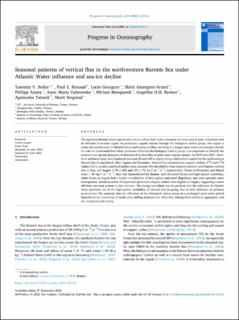| dc.description.abstract | The northern Barents Sea is a productive Arctic inflow shelf with a seasonal ice cover and as such, a location with an efficient downward export of particulate organic matter through the biological carbon pump. The region is under strong influence of Atlantification and sea-ice decline, resulting in a longer open water and summer period. In order to understand how these processes influence the biological carbon pump, it is important to identify the seasonal and spatial dynamics of downward vertical flux of particulate organic matter. In 2019 and 2021, short-term sediment traps were deployed between 30 and 200 m depth along a latitudinal transect in the northwestern Barents Sea during March, May, August and December. Vertical flux of particulate organic carbon, δ13C and δ15N values, Chl-a, protists and fecal pellets were assessed. We identified a clear seasonal pattern, with highest vertical flux in May and August (178 ± 202 and 159 ± 79 mg C m−2 d−1, respectively). Fluxes in December and March were < 45 mg C m−2 d−1. May was characterized by diatom- and Chl a-rich fluxes and high spatial variability, while fluxes in August had a higher contribution of fecal pellets and small flagellates, and were spatially more homogenous. Standing stocks of suspended particulate organic matter were highest in August, suggesting a more efficient retention system in late summer. The strong latitudinal sea-ice gradient and the influence of Atlantic Water probably led to the high spatial variability of vertical flux in spring, due to their influence on primary productivity. We conclude that the efficiency of the biological carbon pump in a prolonged open-water period depends on the reworking of small, slow sinking material into efficiently sinking fecal pellets or aggregates, and the occurrence of mixing. | en_US |
